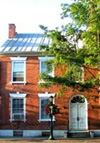Federal Style 1780 -1820
History
The Federal style is also known as the Adam style, after the Adam brothers, British architects who developed this style in England. It is really a refinement of the Georgian style, which was popular in the years preceding the Federal style. Like the Georgian style, the Federal style is designed around center hall floor plan, or side hall for narrow row houses. The Federal style has many of the same elements of the Georgian style - symmetry, classical details and a side gabled roof - yet it is different in its ornamentation and sophistication. Federal details are more delicate, slender and finely drawn than their Georgian counterparts and may feature swags, garlands and urns. Also, more formal elements were introduced in the Federal style, such as the front door fanlight window, sometimes with flanking sidelights, and more elaborate door surrounds and porticos. The Federal style is also known for dramatic windows, three-part or Palladian windows with curved arches. Another outstanding - yet less common - Federal feature is the use of curving or polygonal window projections.
The Federal style became popular throughout the colonies after the American Revolution and was dominant until about 1820, when it was supplanted by the Greek or Classical Revival Style. The easiest way to identify a Federal style building from a Georgian one is to look for the elliptical fan light over the front door or the Palladian windows - not that those design features do not appear in later styles as well. The Federal house in Pennsylvania is usually a brick two or three story building.
Common Building Types
- houses
- schools
- churches
Identifiable Features
- Symmetrical form and fenestration
- Elliptical fan light over paneled front door
- Side lights flanking front door
- Classical details, similar to the Georgian style, but more delicate in size and scale
- Flat lintels over windows, often with bull’s eye corners
- Cornice with decorative moldings, often dentils
- Low pitched side-gable or hipped roof
- Double hung windows with thin muntins separating the panes (6 panes over 6 most common)
- Decorative front door crown or entry porch
- Tripart or Palladian window
- Curving or polygonal projections
Photos
Click the thumbnails for larger images.




